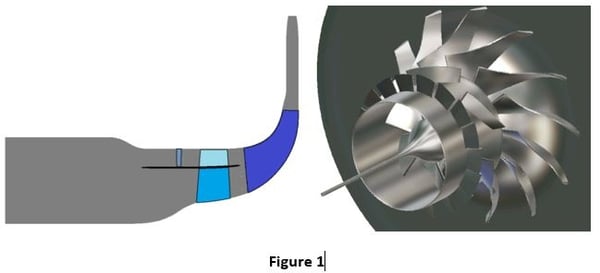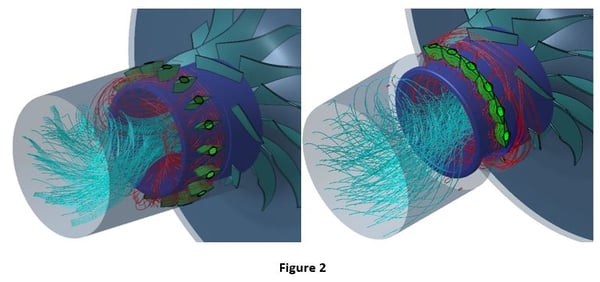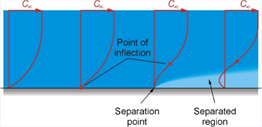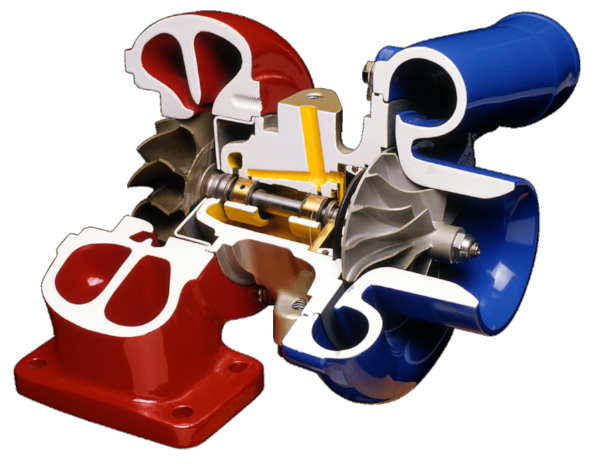Extending the operating range of centrifugal compressors has been a highly sought-after goal for several decades. In fact, the potential benefits have motivated researchers to develop and put into practice many pieces of technology, including full span inlet guide vanes (IGV’s), complex multistage systems with interstage bleed, passive casing treatment, and many others.
One field which stands to really benefit from centrifugal compressor range extension is the automotive turbocharger field, where the compressors are regularly operated at flow rates much lower than their peak output points. After all, selling a vehicle often relies on impressing the customer with high peak power (where the turbocharger sees high flow rates), as well as high mileage (where the turbocharger sees low flow rates).
The characteristic phenomena which limit the range of flow rates along a specified turbocharger speed line are: choke, where the flow reaches a sonic velocity at the output of the compressor wheel and therefore cannot achieve a higher flow rate; and surge, where a region of stalled recirculating flow at the inlet of the compressor wheel grows to an appreciable size and, therefore, inhibits the pressure developing capability of the impeller. Typically, for the latter case, this manifests itself as an unstable oscillation at the point along the flow curve where the pressure ratio peaks and is therefore avoided during operation.
Eliminating or inhibiting that unstable surge mechanism from forming in an automotive turbocharger is precisely the goal of an ongoing Concepts NREC project for the Department of Energy (DOE). Using novel technology developed at Concepts NREC (Figure 1), we were able to extend turbocharger operating range by utilizing partial height IGV’s which regulate flow through a secondary annular bypass region. The regulation of the flow in this bypass region, essentially, inhibited the formation of a stall region at the compressor inlet while redirecting and accelerating flow through the inner core, leading to stable operation at flow points below the previous point of surge.

In Phase II of the project, several candidate configurations will be designed and fabricated, allowing for detailed component testing to be performed. Based on those tests, a preferred configuration will be selected and tested with an engine, relevant to automotive gasoline applications to determine overall engine performance enhancements of the novel technology. Candidate designs will be selected through advanced 3D CFD analysis by evaluating the impact of the partial height IGV on the flow field within the compressor.
During the Phase I project, we found that, with a fully open IGV setting, as flow rate decreases, there exists the tendency for a recirculation to develop, resulting in reverse flow in the bypass region of the impeller (left side of Figure 2). This recirculation mimics that of traditional inlet stall (the inherent mechanism for surge potential) but is instead constrained to a well-defined path around the flow splitter, separating the bypass and core regions. With closed IGV’s, the resulting flow in the bypass region is highly tangential, but fully blocked meridionally (right side of Figure 2). Though this generates losses in this bypass region, it also results in a cleaner flow through the core region, which offsets the negative effects, leading to a net gain in stable operating range.

While a variety of range extension devices have been developed, this novel compressor configuration is proposed, which allows a single compressor to mimic the behavior of a small and a large compressor with minimum complexity. Based on the prior development work, we anticipate this compressor technology to have the following benefits compared to current commercially available turbochargers:
- 3% improvement in fuel economy, compared to a commercial turbocharger, and
- Significantly larger range, allowing low-flow, low-pressure ratio conditions to be achieved that would not be possible with a commercial turbocharger.
Upon our successful completion of Phase II, automotive and truck turbocharger designers and manufacturers will be able to access intellectual property licensing and the associated tools developed. This will help them design and/or produce high performance turbochargers that will operate over a wider range of operating conditions, compared to current commercial turbocharger systems. The benefits of this new breakthrough in compressor design will include increasing fuel economy and reducing emissions without a significant increase in cost, weight or size.







